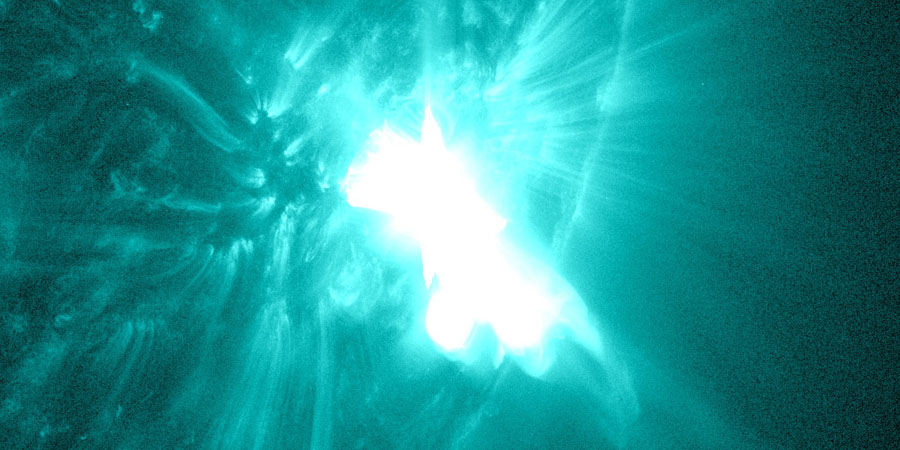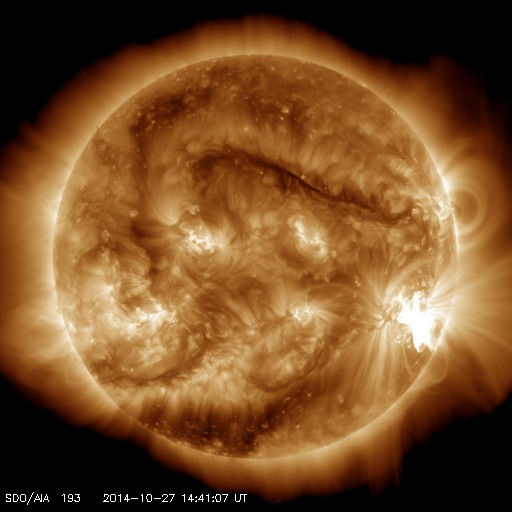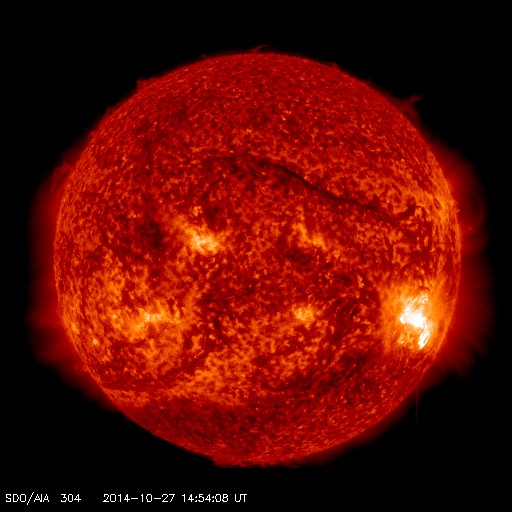X2.0 solar flare from sunspot region 2192
Monday, 27 October 2014 17:55 UTC

Sunspot region 2192 continues to be very active today. It produced numerous M-class solar flares and even a major X-class solar flare: X2.07 (R3-strong radio blackout) at 14:47 UTC. This was already it's sixth X-class solar flare! However, as you might have guessed already... none of the solar flares (not even the X2 solar flare) were eruptive and it looks like none of them produced a coronal mass ejection. It's starting to look like sunspot region 2192 is going into the history books as the large sunspot group that couldn't deliver.
X2.0 solar flare as seen by SDO/AIA 193 Ångström

X2.0 solar flare as seen by SDO/AIA 304 Ångström

Evolution of sunspot region 2192
Sunspot region 2192 is showing signs of decay since our last update. It is loosing penumbral area in it's intermediate layout and around the leader spot. However, there remains a number of strong and tightly packed delta structures near the large trailer spot and it is there where this sunspot region looks relatively stable. Sunspot region 2192 did loose some penumbral area but despite this we can conclude that sunspot region 2192 remains a large and magnetically complex sunspot region which will continue to produce strong solar flares in the coming 24 hours. We keep the percentage chances for strong solar flares the same despite the slight signs of decay. The trailing sunspots remains stable and with the delta structures there we are for sure going to get more fireworks. The risk for more M-class (R1+R2) solar flares in the next 24 hours is very high and an X-class (R3) event remains possible as well. We do need to note that sunspot region 2192 is now slowly rotating away from Earth and any eruptions will be less likely to hit Earth as time passes. We do need to note that a strong eruption from sunspot region 2192 could still cause a solar radiation storm which would impact HF radio communications at arctic latitudes.


All the other sunspot regions on the disk are unremarkable. Any future solar flares will very likely be centered around sunspot region 2192.
Solar flare odds for the coming 24 hours
M-class flare probability: 90% chance
X-class flare probability: 30% chance
Images: NASA SDO.
Thank you for reading this article! Did you have any trouble with the technical terms used in this article? Our help section is the place to be where you can find in-depth articles, a FAQ and a list with common abbreviations. Still puzzled? Just post on our forum where we will help you the best we can!
Latest news
Latest forum messages
Support SpaceWeatherLive.com!
A lot of people come to SpaceWeatherLive to follow the Sun's activity or if there is aurora to be seen, but with more traffic comes higher server costs. Consider a donation if you enjoy SpaceWeatherLive so we can keep the website online!

Space weather facts
| Last X-flare | 2024/12/08 | X2.2 |
| Last M-flare | 2024/12/25 | M4.9 |
| Last geomagnetic storm | 2024/12/17 | Kp5+ (G1) |
| Spotless days | |
|---|---|
| Last spotless day | 2022/06/08 |
| Monthly mean Sunspot Number | |
|---|---|
| November 2024 | 152.5 -13.9 |
| December 2024 | 115.2 -37.3 |
| Last 30 days | 120.1 -38.2 |


